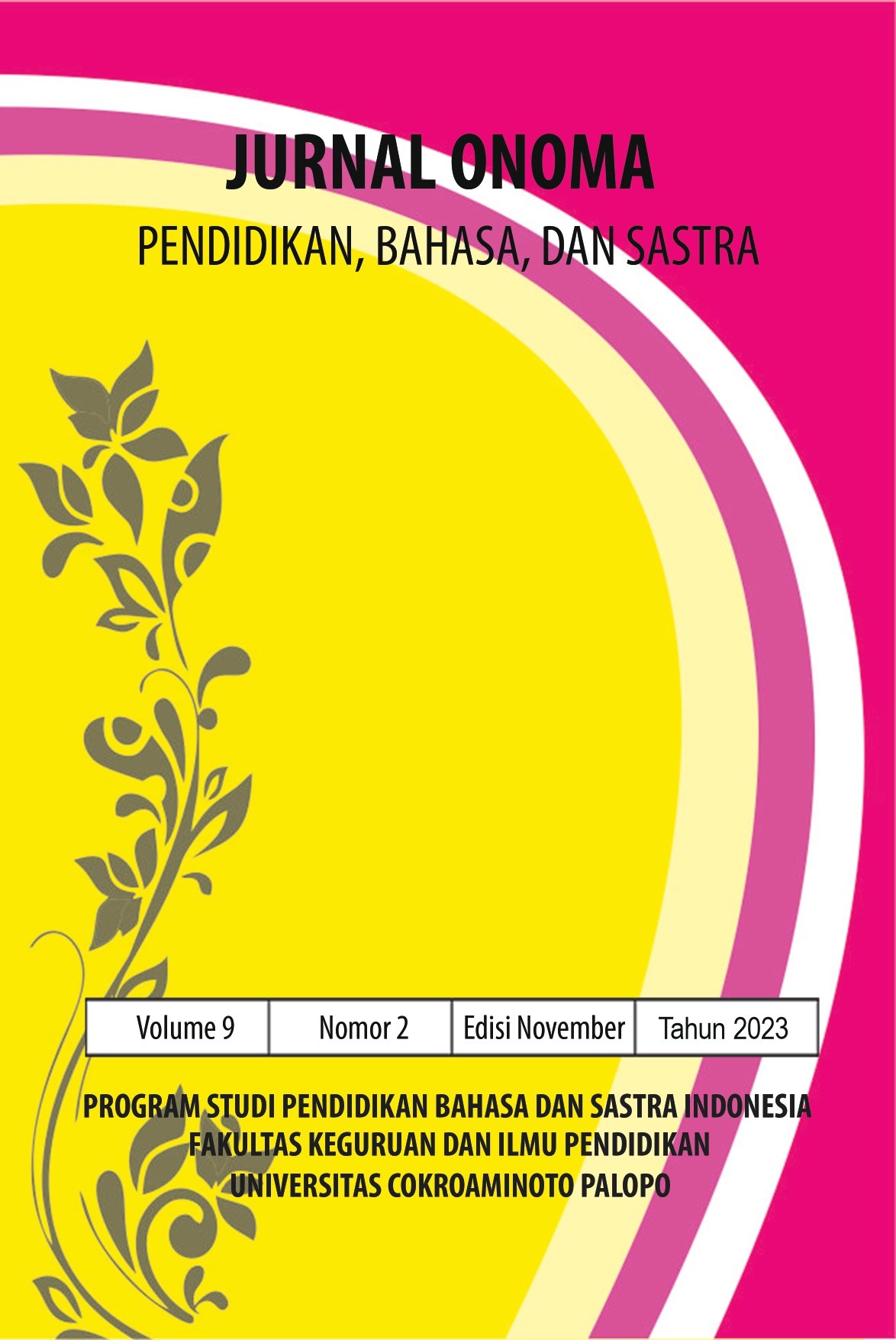Thanking Expression Used By The Characters In The Luca Movie (A Pragmatic Analysis)
https://doi.org/10.30605/onoma.v9i2.2938
Keywords:
Thanking, Type Of Thanking, Strategies Of ThankingAbstract
This study seeks to explain the type of thank-you expression categories and establish the strategy of thank-you expression employed by the character in the movie Luca. The method used in this study was descriptive qualitative. This study used English utterances with thanking expressions as data. The data was documented. Types of thanking expressions were evaluated using Hymes (1972), and strategies of thanking expression were analyzed using Aijmer (1996). In this research, eight types of thank-you expressions were found. The study indicated that 33% of participants acknowledged a major favor, 17% acknowledged a favor, and 11% dismissed a service, ended the conversation, and used irony, sarcasm, or bluntness. 6% of data reveals thanking someone, making them feel good, and negative requests. Moreover, there are four strategies for saying thank you expressions. The data revealed 67% of the data shows thanking somebody explicitly, 17% stressing one's gratitude, 11% showing appreciation of the act, and 6% showing emotion.
Downloads
References
Aijmer, K. (1996). Conversational Routines in English: Convention and Creativity. Longman Singapore Publisher.
Austin, J. (1962). How To Do Things With Words. Cambridge University Press.
Ali Sabah Jameel Al-Khayyat, & Tagreed Fayadh Abdul Razaaq. (2020). Analyzing the Concept of Speech Act of Thanking in the English Textbooks of Primary Schools. Journal of the College of Basic Education, January, 485–496. https://doi.org/10.35950/cbej.vi0.4839 DOI: https://doi.org/10.35950/cbej.vi0.4839
Beloufa, C. (2022). The Speech Act of Thanking in Shakespeare: The Case of Romeo and Juliet and All’s Well that Ends Well. Notion: Journal of Linguistics, Literature, and Culture, 4(1), 9–22. https://doi.org/10.12928/notion.v4i1.5750 DOI: https://doi.org/10.12928/notion.v4i1.5750
Eripuddin, E., Jufrizal, J., & Agustina, A. (2022). The Implied Meaning of Thanking Expressions in Students’ Drama Performance: “The Pursuit of Happyness Drama. AL-ISHLAH: Jurnal Pendidikan, 14(2), 2437–2446. https://doi.org/10.35445/alishlah.v14i2.1431 DOI: https://doi.org/10.35445/alishlah.v14i2.1431
Faqe, C. K., Jbrael, S. J., & Muhammad, K. R. (2019). The Use of Thanking Speech Act Strategies in English Realized by Kurdish EFL Learners at Soran University. Education Quarterly Reviews, 2(3). https://doi.org/10.31014/aior.1993.02.03.95 DOI: https://doi.org/10.31014/aior.1993.02.03.95
Suparman, S., & Charmilasari, C. (2017). Analysis of Phase Structure Realization in Classroom Discourse: A Study of Systemic Functional Linguistics. Ethical Lingua: Journal of Language Teaching and Literature, 4(2), 120-126. DOI: https://doi.org/10.30605/ethicallingua.v4i2.624
Griffiths, P. (2006). An Introduction to English Semantics and Pragmatics. In Edinburgh University Press.
Hilal, M. M., & Kadhim, S. M. (2023). A Socio-pragmatic Study of Thanking in Selected British and American Plays. Resmilitaris, 13. https://resmilitaris.net/menu-script/index.php/resmilitaris/article/view/1517
Hymes, D. H. (1972). On communicative competence. In J.B. Pride and J. Holmes (Eds.), Sociolinguistics. Harmondsworth: Penguin, pp. 269-293.
Ricca, H., & Ambalegin, A. (2022). Expressive Speech Acts Found in Love At First Swipe Web Series. CaLLs (Journal of Culture, Arts, Literature, and Linguistics), 8(1), 13. https://doi.org/10.30872/calls.v8i1.6403 DOI: https://doi.org/10.30872/calls.v8i1.6403
Shinta, A. (2014). A Study of Expressive Gratitude of Thanking Strategy as Used by Efl Learners. 2009, 1–23.
Tran, L. T. B., Ho, N. T., & Hurle, R. J. (2016). Teaching for Creativity Development: Lessons Learned from a Preliminary Study of Vietnamese and International Upper (High) Secondary School Teachers’ Perceptions and Lesson Plans. Creative Education, 07(07), 1024–1043. https://doi.org/10.4236/ce.2016.77107 DOI: https://doi.org/10.4236/ce.2016.77107
VanderStoep, S. W., & Johnston, D. D. (2009). Research methods for everyday life: blending qualitative and quantitative approaches (Vol. 24)
Downloads
Published
How to Cite
License
In submitting the manuscript to the journal, the authors certify that:
- They are authorized by their co-authors to enter into these arrangements.
- The work described has not been formally published before, except in the form of an abstract or as part of a published lecture, review, thesis, or overlay journal.
- That it is not under consideration for publication elsewhere,
- That its publication has been approved by all the author(s) and by the responsible authorities – tacitly or explicitly – of the institutes where the work has been carried out.
- They secure the right to reproduce any material that has already been published or copyrighted elsewhere.
- They agree to the following license and copyright agreement.
License and Copyright Agreement
Authors who publish with Onoma Journal: Education, Languages??, and Literature agree to the following terms:
- Authors retain copyright and grant the journal right of first publication with the work simultaneously licensed under Creative Commons Attribution License (CC BY 4.0) that allows others to share the work with an acknowledgment of the work's authorship and initial publication in this journal.
- Authors are able to enter into separate, additional contractual arrangements for the non-exclusive distribution of the journal's published version of the work (e.g., post it to an institutional repository or publish it in a book), with an acknowledgment of its initial publication in this journal.
- Authors are permitted and encouraged to post their work online (e.g., in institutional repositories or on their website) prior to and during the submission process, as it can lead to productive exchanges, as well as earlier and greater citation of published work.

















